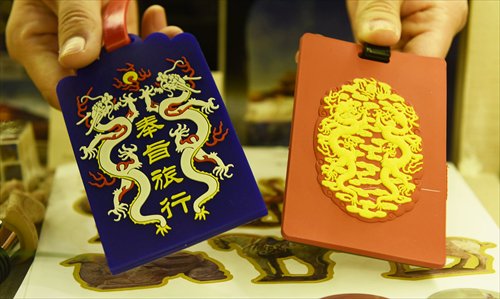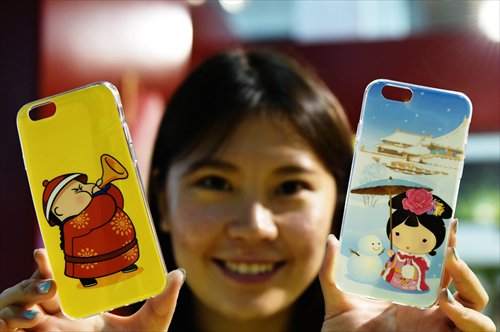China encourages commercialization of museums

Travel tags with dragon designs Photo: IC

A woman shows off phone cases featuring characters wearing traditional clothing. Photo: IC
The dozens of stray cats living in the Forbidden City in Beijing inspired designers to create a feline imperial bodyguard figure that ended up becoming one of the best-selling souvenirs sold at the Palace Museum.
Other items inspired by the Forbidden City have also become hits, such as earphones and umbrellas that look like the necklaces and hats worn by the minsters of the Qing Dynasty (1644-1911).
At a press conference in Beijing on May 19, Palace Museum Curator Shan Jixiang told media that the museum possesses more than 8,700 cultural and creative products, the sales of which reached nearly 1 billion yuan ($152 million) last year.
These successes have set a promising example for other museums in China to follow. However, while many museums may want to design their own cultural and creative products, most still lack the know-how.
Lack of development
While many museums in other countries have developed cultural products to the point that sales of these souvenirs actually bring in more revenue than ticket sales, museums in China have only recently discovered their power.
The lagging development of cultural products is the result of a number of factors. Guan Qiang, vice director of the National Relics Bureau, said that government policy used to be one major obstacle.
"State-owned museums are classified as public institutions, and therefore are not allowed to carry out commercial operations according to regulations. This limits their ability to develop cultural and creative products," he told the media at the press.
Guan also pointed out issues when it comes to financial support, favorable policies and income distribution.
Shan said that although the government supports the development of the cultural industry, investment in developing cultural products is not covered by government funding.
He also added that museums do not include this development as part of their operating budgets.
In addition to these external factors, Shan pointed out that museums are also responsible for cultural products' lack of development, since many museums have no clue how to find the attractive cultural elements from their collections and combine those with elements from modern society.
Support
To solve these issues, the State Council has issued guidelines to departments, including the Ministry of Culture, recently about how to support organizations in the development of cultural products.
These guidelines encourage national-level and provincial-level cultural organizations (museums, galleries, libraries) to experiment with cultural products, allow them to set the prices of these products, as well as allow them to own intellectual property and establish commercial enterprises to manage cultural products.
In addition to these guidelines, the State Administration of Cultural Heritage is currently working on policy that will regulate museums' commercial businesses.
Besides the Palace Museum, the National Museum of China is another success story.
With the support of the State Administration of Cultural Heritage, the National Museum of China was able to hold design competitions for cultural products in 2010 and 2015.
By the end of 2015, the National Museum of China has been involved in the development of more than 3,000 products, with the IP rights to more than half these belonging solely to the museum.
At the May 19 press conference, vice director of the National Museum of China, said that the museum is moving into the e-commerce arena. In addition to an official store on e-commerce platform Tmall, it is also cooperating with Alibaba to establish a platform focused on design and investment issues.
Practical art
An increasing number of museums in China are putting more energy into developing their own cultural products.
The Sanxingdui Museum in Sichuan Province kicked off a design competition on May 18 to attract the public and organizations to submit their designs based on the Bronze age Sanxingdui Culture.
Offering his advice, Shan said that the first thing museums should focus on is making products that have practical uses. Cellphone cases, USB drives, duct tape, batteries for phones, and even soap have all been big hits for the Palace Museum.
By the end of 2015, a total of 4,692 museums were registered nationwide in China.
Newspaper headline: The business of culture